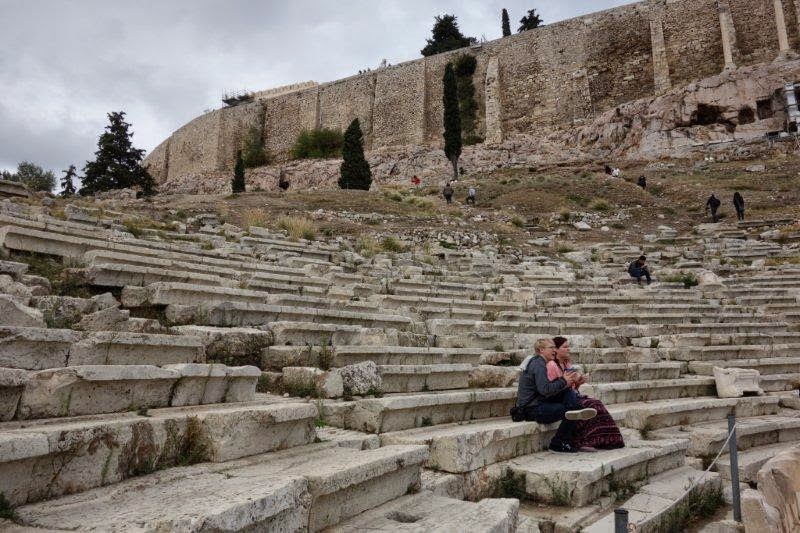There is so much material on the Acropolis on the internet that an unschooled person like me in ancient Greek history can add little value to. We came to Athens because it was only less than four hours away from London and it is the seat of the ancient Greek civilization that counts Aristotle and Plato as their pre-eminent thinkers.
We entered the Arcopolis from the south slope, near the Acropolis Museum. It was a meandering climb, often along unpaved paths. Ruins were littered on the way and we came across a number of Japanese and Chinese tourists taking turns to pose among the ruins. The price of a unified ticket is €12, which includes entry to other major monuments of Ancient Athens (the Agora, the Roman forum, the Temple of Olympian Zeus, the Kerameikos and the theatre of Dionysos). We only managed to use two of the stubs on the ticket so cannot attest to its value.
On the southwest slope lies the beautifully restored Odeon of Herodes Atticus. This is a stunning piece of architecture: the audience stand and the stage were restored using pentelic marble (the material used for many Greek statues seen in various museums at Athens). One can imagine the setting and atmosphere when the theatre plays host to internationally acclaimed artists and orchestras.
And now onto the Acropolis. We were not expecting a huge crowd since it was already autumn, past the peak season. On approaching the Propylaea, the monumental gateway to the Acropolis of Athens, we were slightly overwhelmed by the hustle and bustle. It was windy and chilly on the day, thus adding to the noise (in my head). The gateway is flanked by massive pentelic marble columns and in their unprotected state, caused the stewards to keep barking orders to visitors not to touch them. Some protection would have removed all the aggravation.
Once upon the Acropolis, two large monuments dominated the view. I was actually slightly underwhelmed by the Parthenon, probably the film that I saw about this monument at the Acropolis Museum gave it the grandeur that it has lost due to the massive cranes situated inside the building. It took the Greeks 9 years to build this in 4th century BC, but it has taken the modern day Greeks many years to restore it, the restoration having started since 1975 and is still on-going.
To the north side of the Parthenon lies the Erectheum, an ancient temple dedicated to Athena and Poseidon. I was fascinated to learn that there were six original Caryatids: five have been moved to the Acropolis Museum for exhibition and replaced in situ by exact replicas and the sixth was removed by Lord Elgin and is now exhibited at the British Museum in London. When visiting the museums in Athens, one was constantly reminded of the repatriation of ancient monuments to Greece from Germany and France, but the issue of the so-called Elgin marbles misappropriated from Greece remains contentious. I do not believe that any nation has the right to remove national treasures from other countries, with or without the permission of the ruling government at the time.
The view from the Acropolis was breathtaking. In the distance is Mount Lycabettus, with panoramic view of Athens. Unfortunately we did not have time to visit this place, let alone the funicular railway that would have taken us to the top.
On the way down from the Acropolis, we used the well trodden path on the north slope, and it was a much easier trip.
We entered the Arcopolis from the south slope, near the Acropolis Museum. It was a meandering climb, often along unpaved paths. Ruins were littered on the way and we came across a number of Japanese and Chinese tourists taking turns to pose among the ruins. The price of a unified ticket is €12, which includes entry to other major monuments of Ancient Athens (the Agora, the Roman forum, the Temple of Olympian Zeus, the Kerameikos and the theatre of Dionysos). We only managed to use two of the stubs on the ticket so cannot attest to its value.
 |
| Present day remains of the remains of the Theatre of Dionysos |
 |
| The magnificent Odean of Herodes Atticus |
And now onto the Acropolis. We were not expecting a huge crowd since it was already autumn, past the peak season. On approaching the Propylaea, the monumental gateway to the Acropolis of Athens, we were slightly overwhelmed by the hustle and bustle. It was windy and chilly on the day, thus adding to the noise (in my head). The gateway is flanked by massive pentelic marble columns and in their unprotected state, caused the stewards to keep barking orders to visitors not to touch them. Some protection would have removed all the aggravation.
 |
| The Propulaea, entrance to the Acropolis |
 |
| The Parthenon |
 |
| The Erectheum from the south, with the Porch of the Caryatids on the east side |
The view from the Acropolis was breathtaking. In the distance is Mount Lycabettus, with panoramic view of Athens. Unfortunately we did not have time to visit this place, let alone the funicular railway that would have taken us to the top.
 |
| Mount Lycabettus from The Acropolis |
 |
| View of the Acropolis from the south slope |
